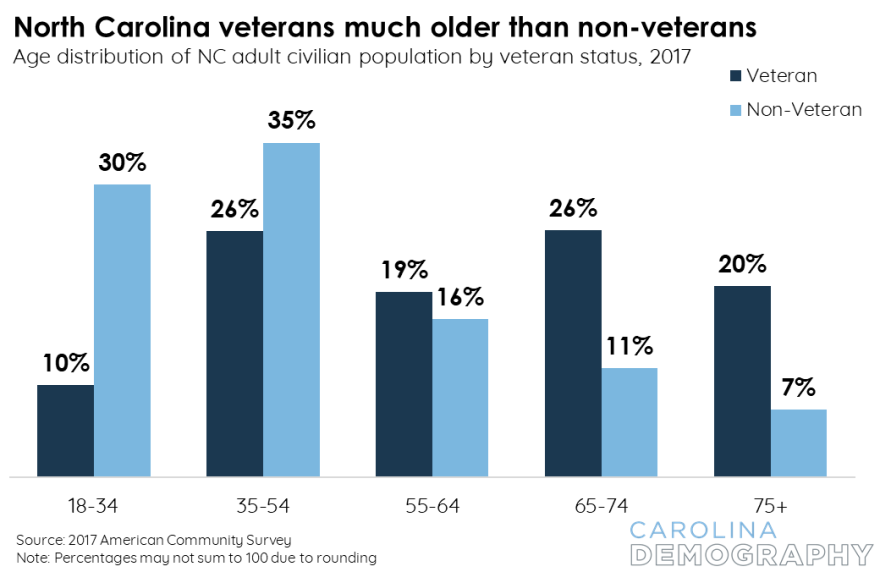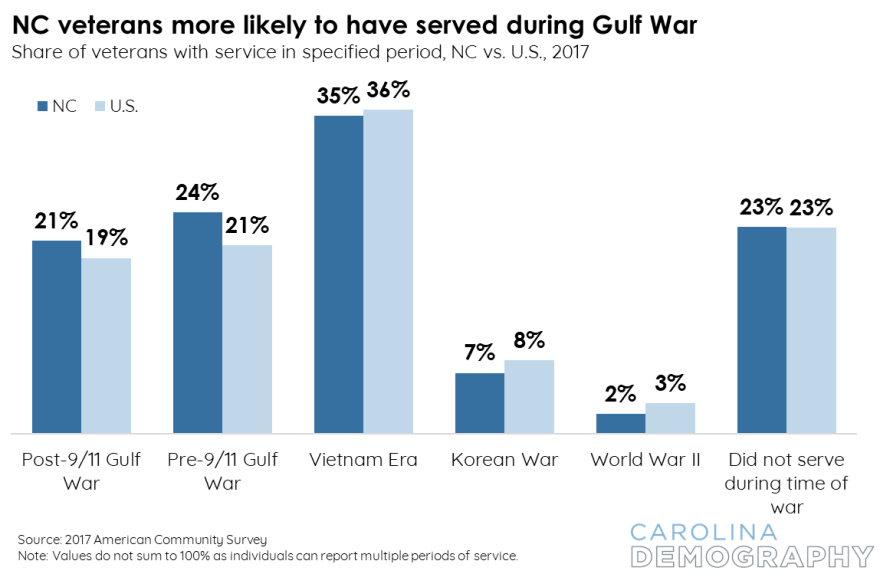North Carolina is home to two of the world’s largest military bases — the Army’s Fort Bragg and the Marine Corps’ Camp Lejeune — but the state’s population of veterans is steadily declining.Last year the number of veterans in North Carolina dropped to about 656,000. That’s down nearly 90,000 from a decade earlier, according to US census bureau estimates.
The number has steadily fallen from a plateau a decade ago. That’s despite the substantial rise in the state’s overall population, according to a new report from UNC.
A big reason that the population is falling off so much is that the veterans of the draft-fueled buildup during the Vietnam War era now dominate the veteran population, but are “aging out ” said Rebecca Tippett is the director of Carolina Demography at the Carolina Population Center.
The veteran population is older than the average, she said.
“The result of that is that you’re going to see much higher mortality rates, and overall population decline because young veterans are not replacing older veterans at a fast enough rate and are not likely to,” Tippett said.

So the population of veterans is essentially being diluted. But not everywhere in the state.
“We do still see communities like Cumberland, Harnett, Hoke County… those regions have very high veteran presence as do Pender, Onslow, that region, because many individuals who are veterans end up living near the community where where they were stationed,” she said.
“And there is some indication that there is a retiree influence, particularly in our costal ares, so those communities are going to have much higher overall concentrations of veterans than the over all state.
The statewide and national decline is expected to continue for years to come. And it is changing things. It’s a big cause of the shrinking membership — and some veterans fear shrinking political clout — among traditional veterans groups, like the American Legion and the VFW.
But the downward trend isn’t the only big shift under way in the demographics of veterans, Tippett said.
“Some of the biggest changes we’re seeing in terms of who’s in the military, is that we’re seeing more female veterans than historically and that’s largely because were seeing higher participation rates by women in the militia,” she said.
And the effects of the increasing number of female veterans are unusually strong in North Carolina, were nearly 11 percent of veterans already are women compared with less than 9 percent nationally.
This is changing things, too. Female membership in veterans groups is up, and it’s sparking the creation of less-traditional advocacy groups, like the Service Women’s Action Network.

Another place this is having an impact is the with VA healthcare system.
Despite the downturn in the number of veterans, the VA here has been seeing its enrollment grow, as a higher percentage of veterans sign up for VA care.
And the number of women enrolled has jumped more than 30 percent in the past five years, said Shenekia Williams-Johnson, women’s program manager for the VA healthcare region that includes North Carolina, most of Virginia and part of West Virginia.
“Which puts us at the second highest growth of women in the country, and yes, it’s a challenge,” she said. But it’s exciting to see that the number of women who are actually coming to us for care are choosing VA for their healthcare needs and I think one issue is that we have had to make our environment more welcoming of women.”
In response to that growth, the VA has done things like creating women's health clinics inside medical centers, some with separate entrances. It also has at least one gynecologist at each center in the region, and has added services like mammograms in some of its facilities, she said.
The VA will need to keep adjusting: Nearly 63,000 women are enrolled in the region, and that number is expected to continue to climb by another 30 percent in the next five years.










